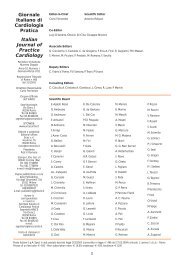Scarica il documento in formato pdf (556 KB) - ANCE
Scarica il documento in formato pdf (556 KB) - ANCE
Scarica il documento in formato pdf (556 KB) - ANCE
Create successful ePaper yourself
Turn your PDF publications into a flip-book with our unique Google optimized e-Paper software.
Correspond<strong>in</strong>g author: Prof. Sergio Coccheri<br />
Università di Bologna<br />
Via Massarenti, 9 - 40138 Bologna<br />
Tel e Fax 051 6364668, E-ma<strong>il</strong> coccheri@med.unibo.it, trombosi@orsola-malpighi.med.unibo.it<br />
It J Practice Cardiol is ava<strong>il</strong>able at http://www.ancecardio.it<br />
Epidemiological notes<br />
The <strong>in</strong>cidence of confirmed venous<br />
thromboembolism (VTE) <strong>in</strong> the overall<br />
population, evaluated as Deep Ve<strong>in</strong><br />
Thrombosis (DVT), ranges between 1<br />
and 2 cases per 1000 subjects per<br />
year (1).<br />
In the hospitalized population asymptomatic<br />
DVT is <strong>in</strong>deed very frequent(2):<br />
phlebographic <strong>in</strong>vestigations have<br />
shown an <strong>in</strong>cidence of "<strong>in</strong>strumental"<br />
DVT without prophylaxis as high as 40-<br />
60% <strong>in</strong> patients after orthopedic surgery,<br />
25% after oncological surgery,<br />
20% after general gynecological surgery<br />
etc. Regard<strong>in</strong>g "medical" patients, phlebographic<br />
DVT rates vary from 30% <strong>in</strong><br />
patients with stroke or heart fa<strong>il</strong>ure, to<br />
14-15% <strong>in</strong> patients with acute medical <strong>il</strong>lnesses.<br />
VTE has a surpris<strong>in</strong>gly high all-cause<br />
mortality rate, amount<strong>in</strong>g to 28% with<strong>in</strong><br />
the first 30 days and to 36% with<strong>in</strong> one<br />
year (1). Early death is due to fatal pulmonary<br />
embolism <strong>in</strong> 20% of the lethal<br />
cases. In the rema<strong>in</strong><strong>in</strong>g cases, mortality<br />
is due to the underly<strong>in</strong>g condition<br />
(other surgical complications, heart or<br />
lung disease, malignancy), as DVT often<br />
occurs <strong>in</strong> the more seriously <strong>il</strong>l patients.<br />
Among "ambulatory" patients who refer<br />
to Thrombosis Services for suspected<br />
DVT, about 20% really have DVT.<br />
The ma<strong>in</strong> criteria for DVT suspicion are<br />
listed <strong>in</strong> standard scores among which<br />
the most used are those proposed by<br />
Wells.<br />
Ma<strong>in</strong> risk factors<br />
In the recent Olmstedt County study<br />
(1) ma<strong>in</strong> risk factors for VTE appeared<br />
to be: hospitalization for surgery or<br />
medical <strong>il</strong>lnesses, trauma, malignancy<br />
with or without chemotherapy, neurologic<br />
disease with extremity paresis,<br />
and prior superficial ve<strong>in</strong> thrombosis.<br />
However, <strong>in</strong> the female sex, pregnancy,<br />
puerperium and the use of oral contraceptives<br />
are very relevant additional<br />
risk factors (3,4). Regard<strong>in</strong>g more specifically<br />
Pulmonary Embolism (PE), <strong>in</strong><br />
the ICOPER study (5), a recent or previous<br />
diagnosis of DVT or PE, an <strong>in</strong>creased<br />
body mass <strong>in</strong>dex, surgery with<strong>in</strong><br />
2 months, bedrest for more than 5<br />
days, cancer, current cigarette smok<strong>in</strong>g,<br />
chronic obstructive pulmonary disease,<br />
trauma, and congestive heart fa<strong>il</strong>ure<br />
emerged as the ma<strong>in</strong> risk predictors. A<br />
known hypercoagulable state was present<br />
<strong>in</strong> 5% of the cases.<br />
The thromboph<strong>il</strong>ic states<br />
Among primary thromboph<strong>il</strong>ic states a<br />
clear dist<strong>in</strong>ction is necessary. A first<br />
group of thromboph<strong>il</strong>ias, namely the<br />
coagulation <strong>in</strong>hibitor deficiencies as Antithromb<strong>in</strong><br />
III, Prote<strong>in</strong> C and Prote<strong>in</strong> S<br />
defects, carry a high risk of VTE. However,<br />
as these defects are very rare <strong>in</strong><br />
the general population, their "attributable"<br />
risk <strong>in</strong> patients with VTE rema<strong>in</strong>s<br />
low. On the contrary, the more recently<br />
described thromboph<strong>il</strong>ic mutations of<br />
factors V and II carry only a moderate<br />
to low risk of cl<strong>in</strong>ical disease, but their<br />
high prevalence <strong>in</strong> the general population<br />
(5 to 8%) makes their "attributable"<br />
risk relevant. Furthermore, wh<strong>il</strong>st<br />
<strong>in</strong> the first group (<strong>in</strong>hibitor deficiencies)<br />
DVT episodes are of generally early onset<br />
and unprovoked, <strong>in</strong> the second<br />
group DVT is frequently triggered by<br />
concomitant acquired risk circumstances,<br />
the onset of first episode may be<br />
belated, and fam<strong>il</strong>y history may be undependable<br />
(6).<br />
Among the acquired, concomitant risk<br />
circumstances, a special role must be<br />
attributed to hormonal oral contraceptives<br />
(OC) (7,8). We also have addres-<br />
S. Coccheri<br />
Venous Thromboembolism<br />
31
















